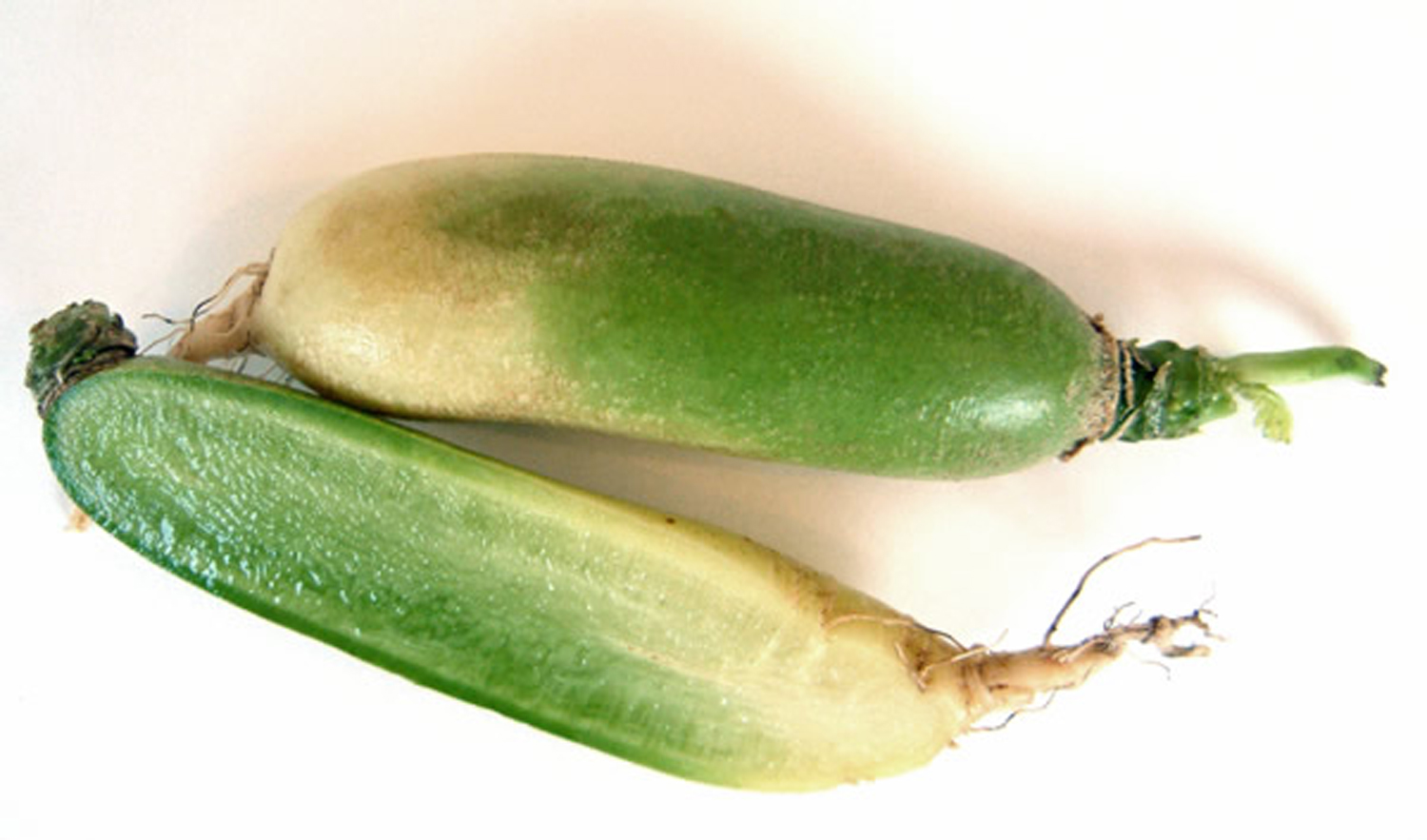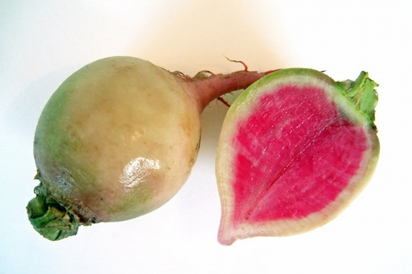All About Winter Radishes
The common round red radishes available throughout the year on produce and buffet counters are known as spring radishes, but these only provide a hint of what is available in the world of radishes. Winter radishes differ in size, shape, colour and flavour. Their bite can vary from mildly spicy to fierily pungent. Cooked radishes become a completely new vegetable—a welcomed antidote to winter root vegetable monotony. Getting to know winter radishes will provide you with one more convincing argument that eating seasonally need not be boring.
Raphanus sativus ("a quickly growing cultivated plant") is a very appropriate scientific name for radishes since they geminate and grow exceedingly quickly. From seeding to harvest takes a mere twenty to thirty days for spring radishes and only two to three months for the winter varieties. This is why growing them can be so much fun for children and for new gardeners.
Historical Record
The origin of radishes is in Southeast Asia. The Chinese started to domesticate them in the third century B.C. These likely looked and tasted like the China Rose variety still available today from many seed companies and in Asian produce markets. The cultivation of radishes soon spread westward through India, Greece and the Roman Empire in much the same form.
It was not until the fourteenth century A.D. that Italians developed the fast-growing small round red varieties we still enjoy today. Quick growth during cool springs made them a popular early vegetable. In the fifteenth century, carrot-shaped white or red icicle radishes became a popular form because they could be grown quite densely in expensive-to-run winter greenhouses.
By the sixteenth century, breeders were introducing winter radish varieties which could be conveniently started in late summer for a late fall harvest. Productive crops could be easily stored in bins all winter long. The most popular of these was the Spanish black radish, which became a reliable winter staple for peasants throughout Europe. Its high vitamin C content prevented scurvy.
Radishes of all sorts remained a daily staple—for breakfast, lunch and dinner—until the twentieth century. The availability of so many out-of-season imported crops led to the demise of winter radishes. But now in the twenty-first century the monotony of same-old winter vegetables is leading to the return of a most interesting family of winter staples.
Quality Growing
Winter radish varieties to consider growing:
- Watermelon (also known as valentine, misato rose, beauty heart, mantanghong, rose heart or red meat): Round with a green/white skin contrasting with a stunning fuchsia interior, these provide a delicious nutty sweet flavour.
- Green Meat (aka misato green, or green luobo): Cylinder-shaped with green skin and flesh on the portions growing above ground. To produce radishes with more green, seed them closely together (one inch apart) to force them to grow upwards.
- Hilds Blauer: Purplish blue skin with nutty white flesh. Germans enjoy salted slices as a snack in beer halls.
- Black Spanish: Coal black skins and pure white flesh with firm texture and a strong radish flavour. I prefer the more convenient cylinder shape and the milder flavour of the "long black" to the more common round version.
- Daikon: A root that can grow to be huge (as large as your arm) and remains tender throughout. Being rather mild and watery, it is not as long-lasting as the other winter radishes. Firm and tender, they are often elaborately carved into edible garnishes throughout many parts of Asia.
Radishes are notoriously easy to grow. Timing of the harvest, however, can be a challenge. (Harvesting spring radishes even a couple of days past their prime often leads to woody, pithy and pungent specimens.) Winter Radishes are more forgiving, but left in wet soil for too long they can split open; in dry soil they stop growing and fail to develop their characteristic rich flavour and sweetness. If the temperature falls below about minus-5º C, they could incur frost damage, which shortens storage life.
Since radishes grow so quickly, it is helpful to gently loosen the soil to reduce any impediments to root growth. If the soil is heavy, jiggle it with a digging fork (do not turn the soil with a shovel) prior to planting the seeds thinly, i.e., spacing them about the distance of the final radius of the fully grown roots. If you prefer smaller radishes, seed about 1/4-inch deep; for larger roots put them in about one inch deep.
Radishes grow best in cool (5º to 15º C) conditions. Quality declines when temperatures are regularly above 20º C, so for our climate, start winter radishes the middle of August. (Fast-growing spring radishes should be started as soon as the soil can be worked in late April to early May.)
Radishes do suffer from some pests—flea beetles, swede midge and cabbage root fly. But by the middle of August these have all generally returned to their winter hibernation. Since the root-tunnelling maggots of the cabbage root fly (which looks just like a housefly) are so damaging, sprinkling wood ash on the soil around the young radishes is a good deterrent.
As your radishes grow, keep the soil damp (but not wet). For larger roots, thin them to separate each plant by more than the final diameter you wish it to grow to (about 2 to 4 inches). Start harvesting when they have grown large enough and turned sweet enough. Do your main harvest in November prior to a hard freeze (when the forecast is below minus-5º C). Store them in plastic bags with a few holes to let them breathe. When kept at 0° to 1º C they will remain a good condition until your first batch of spring radishes is ready to harvest.
Uses for Winter Radishes
If you can't wait for your roots to mature, radish leaves are a delicious (and nutritious) leafy green. Use them in the same way as cooked spinach, chard or kale. They are simply wonderful stirred into a potato soup or into some nearly cooked pasta. An historical way to enjoy radishes is for breakfast with dark bread, butter and salt (or, on a very special day, with an anchovy). One-hour radish pickles are thinly sliced winter radish tossed with a squeeze of lemon juice and a grind of sea salt. These add a fresh, crunchy accompaniment to any main course.
Winter radishes can be cut into chunks and then: sweated with a little oil in a frying pan until glazed; roasted with a bit of oil in a 400° F oven until golden; simmered in a stew until soft; or stir-fried until glistening. Thick slices can be grilled until they have developed the requisite grill marks and are heated through. Raw winter radishes can be: finely diced into potato or egg salad; shredded into a slaw; or thinly sliced and laid on top of an open-faced cream-cheese sandwich.
Roots left in the ground (or replanted in the spring) might re-sprout and bolt (send up a flower shoot). These spring flowers are also edible, or you can wait a couple of weeks for the tender green seedpods to form. These can be used as yet another raw or cooked vegetable.
Radish Risotto
Makes 4 servings
The creamy base of Italian short-grain rice is a most appealing background for whatever ingredients are in season.
- 7 cups blend of vegetable or chicken broth, water and white wine
- 1 tsp sea salt, plus more as needed
- 2 tbsp unsalted butter
- 4 cipollini onions or shallots, peeled and cut into slivers
- 2 cups arborio, carnarole or vialone nano rice
- 2 pounds skin-on radish, diced
- 1/2 cup grated Parmigiano-Reggiano or pecorino Romano cheese, plus 1/4-cup additional shredded cheese for serving
- Freshly ground black pepper, to taste
In a medium saucepan, bring the broth, water, wine and salt to a simmer. In a large saucepan or sauté pan, heat the butter over medium heat. Cook the onions, stirring occasionally until soft, 4 to 5 minutes. Add the rice, stirring continuously for about 2 minutes. Add one cup of the hot liquid, stirring almost continuously. When this liquid is almost totally absorbed, continue stirring in the hot liquid, one cup at a time (stirring in the diced radish while adding the third cup). After the sixth cup of liquid has been almost absorbed, taste the rice to check the texture. (A good risotto should be al dente.) Add up to one more cup of hot liquid, as needed. (The risotto should still be a bit runny when served.) Stir in the cheese. Serve in bowls topped with some additional grated cheese and some freshly ground black pepper.






